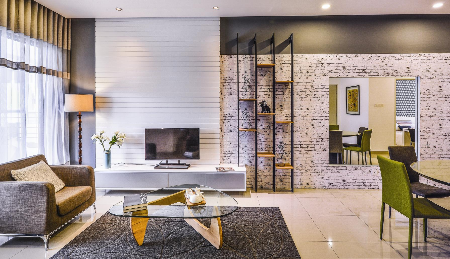Before setting out on your journey of acquiring living room furniture, consider the function, size, orientation, and shape of the space - then the style, material, and colour of your furnishings.
Filling any blank canvas requires the poise and confidence of an accomplished artist, but there is so much more than one's creative pride at stake when it comes to the kind of space that imparts first impressions like the average living room does. There are minimalist furnishings that may render a large space empty, there are button-backed leather Chesterfields that can overwhelm an urban apartment, and then there are modern contemporary sofas that seem to fit anywhere.
 Image Credit: Design Base
Image Credit: Design Base
With all the available sizes and styles of furnishings available, you may find yourself hard pressed to assemble a cohesive arrangement with varied pieces from different manufacturers. Armed with this guide and the critical considerations it presents, we believe your next search for living room furniture will produce more effective results.
Function
The first thing to do before furnishing any space is to pose the question of what one intends to do with it. Is your home a hub for large clan gatherings or more likely reserved for a select few? The approaches to furnishing your living room would differ depending on whether you are assembling a bachelor pad hangout or a lounge for a large family - the latter typically requires more seating, including the requisite pair of matching armchairs for the matriarch and patriarch of the clan, while the former could be adequately furnished with a single sofa set in close proximity to a coffee table.
 Interior design by: Q1 Interior Concept
Interior design by: Q1 Interior Concept
Size
With the role of the living room decided, one would have to take a look at what space there is to work with. In addition to floor space, one should also consider the presence and height of walls demarcating the area. First of all, is the lounge part of an open plan concept or is it enclosed in walls? A room surrounded by walls limits ingress and egress options, making arrangements more dependant on the placement of walls - on the other hand, an open layout leaves more to the imagination.
 Interior design by: The Home Concept Furniture
Interior design by: The Home Concept Furniture
Secondly, does the height of the ceiling make for a double volume space? A double-height ceiling will enable the incorporation of furnishings with high profiles to take advantage of the extra airspace, while a conventional ceiling may require furnishings of lower height so as to not overwhelm the sense of volume.
Lastly, what is the traffic flow around the house going to look like? If the living room is located more at the core of the house, walkways between furnishings would have to be considered, less so if it is a secluded corner.
 Interior design by: The Roof Studio
Interior design by: The Roof Studio
Shape
In addition to the size of the living room, the shape of a space will have an effect on the furnishings you select. An especially long and narrow lounge may not benefit from many round furnishings placed in the centre, while a square room will appear rather empty with the majority of furnishings hugging the walls.
 Interior design by: ID Industries
Interior design by: ID Industries
There exists a number appearing in both natural and produced designs that have been found to be aesthetically pleasing since the Italian Renaissance - the golden ratio of 1.618 has often been used to produce compositions that are universally regarded as beautiful. Applying this ratio to your own compositions will almost certainly guarantee an appealing arrangement: if you have an especially long space, consider visually subdividing it with pieces of seating or table surfaces to achieve a space where the length divided by width produces a number approaching the golden ratio.
Orientation
Another factor with significant weight on the effect of your furnishings is the orientation of the space, which affects the amount of sunlight your living room receives as the sun transits across the sky during the day. Material choices for your furnishings could be swayed by varying levels of sunlight at different times of day, so we recommend keeping a few sample swatches around to compare before settling on a material. Coupled with the consideration of natural lighting is the presence of windows providing scenic views - furnishings with low profiles may be considered to preserve the view, while high-backed seating could be made less intrusive by being positioned against a wall.
 Interior design by: The Roof Studio
Interior design by: The Roof Studio
Style
Prior considerations with regard to the function, size, shape, and orientation of the living room are less controllable - but the choice of style for your furnishings is where your personality will be more obviously presented. Before settling on your choice of furnishings, decide on whether you want your living room to be dedicated to the hallmarks of particular styles, such as the traditional trappings of classical style or dispense with all the frills for a minimalist decor - or maybe you would want to consider putting together your own unique assembly to present a more eccentric image.
 Interior design by: The Home Concept Furniture
Interior design by: The Home Concept Furniture
Materials
The choice of material for your furnishing is largely dependant on the function of the space, the lighting levels, and the style you want to achieve. Metal and wood frames are compatible with a wide range of styles, with reflective surfaces being more suited for spaces with a modern lean. Suede and fabric upholstery may be delectable to the senses, but tougher materials like leather may be more suitable in homes with children or pets.
 Interior design by: Surface R
Interior design by: Surface R
Colour
It probably goes without saying that the shades and tones of your living room furniture should be selected according to your personal preference, albeit with attention paid to the subtle effects of colour on moods, the appearance of colours in changing light conditions, and matching or complementing furnishings with the base or accent colours in architectural finishes.
 Interior design by: X-Two Concept
Interior design by: X-Two Concept
Completely saturating a room in various shades of a single colour is an easy way to get around most of the additional considerations of matching or complementing with base or accent colours, while imposing into a space a favoured hue and its effects on mood.
 Interior design by: Gusto Design & Build
Interior design by: Gusto Design & Build







Leave your comment